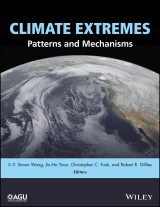Details

Climate Extremes
Patterns and MechanismsGeophysical Monograph Series, Band 226 1. Aufl.
|
176,99 € |
|
| Verlag: | Wiley |
| Format: | |
| Veröffentl.: | 15.06.2017 |
| ISBN/EAN: | 9781119068037 |
| Sprache: | englisch |
| Anzahl Seiten: | 400 |
DRM-geschütztes eBook, Sie benötigen z.B. Adobe Digital Editions und eine Adobe ID zum Lesen.
Beschreibungen
<p>Although we are seeing more weather and climate extremes, individual extreme events are very diverse and generalization of trends is difficult. For example, mid-latitude and subtropical climate extremes such as heat waves, hurricanes and droughts have increased, and could have been caused by processes including arctic amplification, jet stream meandering, and tropical expansion. This volume documents various climate extreme events and associated changes that have been analyzed through diagnostics, modeling, and statistical approaches. The identification of patterns and mechanisms can aid the prediction of future extreme events. </p> <p>Volume highlights include:</p> <ul> <li>Compilation of processes and mechanisms unique to individual weather and climate extreme events</li> <li>Discussion of climate model performance in terms of simulating high-impact weather and climate extremes</li> <li>Summary of various existing theories, including controversial ones, on how climate extremes will continue to become stronger and more frequent </li> </ul> <p><i>Climate Extremes: Patterns and Mechanisms </i>is a valuable resource for scientists and graduate students in the fields of geophysics, climate physics, natural hazards, and environmental science.<br /><br />Read an interview with the editors to find out more:<br /><a href="https://eos.org/editors-vox/how-does-changing-climate-bring-more-extreme-events" target="_blank">https://eos.org/editors-vox/how-does-changing-climate-bring-more-extreme-events</a></p>
<p>Contributors vii</p> <p>Preface xi</p> <p>Acknowledgments xiii</p> <p><b>Part I: Forcings of Climate Extremes</b></p> <p>1 The Changing El Nino–Southern Oscillation and Associated Climate Extremes<br /><i>Jin</i><i>?-</i><i>Yi Yu, Xin Wang, Song Yang, Houk Paek, and Mengyan Chen 3</i></p> <p>2 Weather Extremes Linked to Interaction of the Arctic and Midlatitudes<br /><i>Timo Vihma 39</i></p> <p>3 Impact of Aerosols on Regional Changes in Climate Extremes<br /><i>Jana Sillmann and Jinho Yoon 51</i></p> <p>4 Weakened Flow, Persistent Circulation, and Prolonged Weather Extremes in Boreal Summer<br /><i>Dim Coumou, Kai Kornhuber, Jascha Lehmann, and Vladimir Petoukhov 61</i></p> <p>5 Land Processes as the Forcing of Extremes: A Review<br /><i>Min</i><i>?-</i><i>Hui Lo, Tzu</i><i>?-</i><i>Hsien Kuo, Hao</i><i>?]</i><i>Wei Wey, Chia</i><i>?-</i><i>Wei Lan, and Jen</i><i>?-</i><i>Ping Chen 75</i></p> <p><b>Part II: Processes of Climate Extremes</b></p> <p>6 Timing of Anthropogenic Emergence in Climate Extremes<br /><i>Andrew D. King, Markus G. Donat, Ed Hawkins, and David J. Karoly 95</i></p> <p>7 Recent Increases in Extreme Temperature Occurrence over Land<br /><i>Scott J. Weaver, Arun Kumar, and Mingyue Chen 105</i></p> <p>8 Why Future Shifts in Tropical Precipitation Will Likely Be Small: The Location of the Tropical Rain Belt and the Hemispheric Contrast of Energy Input to the Atmosphere<br /><i>Aaron Donohoe and Aiko Voigt 115</i></p> <p>9 Weather?]Climate Interactions and MJO Influences<br /><i>Paul E. Roundy, Naoko Sakaeda, Kyle MacRitchie, and Lawrence Gloeckler 139</i></p> <p>10 Recent Climate Extremes Associated with the West Pacific Warming Mode<br /><i>Chris Funk and Andrew Hoell 165</i></p> <p>11 Connections Between Heat Waves and Circumglobal Teleconnection Patterns in the Northern Hemisphere Summer<br /><i>Haiyan Teng and Grant Branstator 177</i></p> <p><b>Part III: Regional Climate Extremes</b></p> <p>12 North American Drought and Links to Northern Eurasia: The Role of Stationary Rossby Waves<br /><i>Hailan Wang, Siegfried D. Schubert, and Randal D. Koster 197</i></p> <p>13 The California Drought: Trends and Impacts<br /><i>Shih</i><i>?]</i><i>Yu (Simon) Wang, Jinho Yoon, Robert R. Gillies, and Huang</i><i>?-</i><i>Hsiung Hsu 223</i></p> <p>14 Observed Trends in US Tornado Frequency<br /><i>Adam J. Clark 237</i></p> <p>15 Mechanisms Explaining Recent Changes in Australian Climate Extremes<br /><i>Sophie C. Lewis, David J. Karoly, Andrew D. King, Sarah E. Perkins, and Markus G. Donat 249</i></p> <p>16 Unraveling East Africa’s Climate Paradox<br /><i>Bradfield Lyon and Nicolas Vigaud 265</i></p> <p>17 A Physical Model for Extreme Drought over Southwest Asia<br /><i>Andrew Hoell, Chris Funk, Mathew Barlow, and Forest Cannon 283</i></p> <p><b>Part IV: Prediction of Climate Extremes</b></p> <p>18 Extratropical Precursors of the El Nino–Southern Oscillation<br /><i>Kathy V. Pegion and Christopher Selman 301</i></p> <p>19 North Atlantic Seasonal Hurricane Prediction: Underlying Science and an Evaluation of Statistical Models<br /><i>Philip J. Klotzbach, Mark A. Saunders, Gerald D. Bell, and Eric S. Blake 315</i></p> <p>20 Predicting Subseasonal Precipitation Variations Based on the Madden?]Julian Oscillation<br /><i>Charles Jones 329</i></p> <p>21 Prediction of Short?]Term Climate Extremes with a Multimodel Ensemble<br /><i>Emily J. Becker 347</i></p> <p>22 Toward Predicting US Tornadoes in the Late 21st Century<br /><i>Adam J. Clark 361</i></p> <p>Index 371</p>
<p><b> S.-Y. Simon Wang,</b> Utah State University, USA</p> <p><b> Jin-Ho Yoon,</b> Gwangju Institute of Science and Technology, Republic of Korea</p> <p><b> Christopher C. Funk,</b> United States Geological Survey, USA</p> <p><b> Robert R. Gillies,</b> Utah State University, USA</p>
<p> Although we are seeing more weather and climate extremes, individual extreme events are very diverse and generalization of trends is difficult. For example, mid-latitude and subtropical climate extremes such as heat waves, hurricanes and droughts have increased, and could have been caused by processes including arctic amplification, jet stream meandering, and tropical expansion. This volume documents various climate extreme events and associated changes that have been analyzed through diagnostics, modeling, and statistical approaches. The identification of patterns and mechanisms can aid the prediction of future extreme events. <p> Volume highlights include: <ul> <li>Compilation of processes and mechanisms unique to individual weather and climate extreme events</li> <li>Discussion of climate model performance in terms of simulating high-impact weather and climate extremes</li> <li>Summary of various existing theories, including controversial ones, on how climate extremes will continue to become stronger and more frequent</li> </ul> <br> <p><i> Climate Extremes: Patterns and Mechanisms</i> is a valuable resource for scientists and graduate students in the fields of geophysics, climate physics, natural hazards, and environmental science.

















